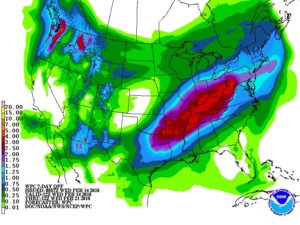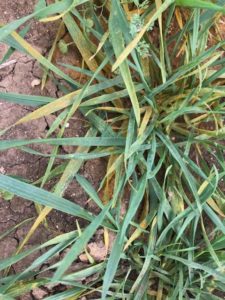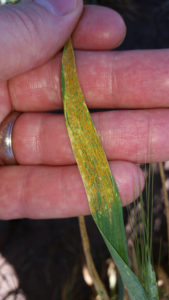by Dr. Clark Neely, Statewide Small Grains Extension Specialist, Texas A&M AgriLife Extension
Dr. Emi Kimura, Regional Extension Agronomist, Texas A&M AgriLife Extension
Dr. Tom Isakeit, Extension Field Crops Pathologist, Texas A&M AgriLife Extension
For wheat growers in a good chunk of the state, we are finally getting some beneficial rain (unfortunately this does not include the Panhandle). This is good news with more and more of the state slipping into exceptionally dry or drought conditions this winter. However, with spring rains sometimes comes rust pressure in wheat fields. With many research plots being top-dressed in the past two weeks, there’s been an opportunity to scout wheat across central and south Texas.
The first report of stripe rust occurred last week in Uvalde, TX. At that time, infection was mainly confined to the susceptible border check ‘Patton’, with little disease present in the main variety trial. So far this is the only reported incidence of the disease as plots in Castroville, College Station, Thrall, McGregor, Hillsboro, and Muenster showed no obvious signs of leaf or stripe rust. A few leaf rust pustules could be found at Uvalde, but in very low numbers. Despite the low incidence of both diseases, stripe rust development favors cool temperatures and wet conditions, both of which are forecasted for the next 7-10 days. Stripe rust prefers nighttime temperatures below 60oF, with optimum development and spread between 50-60oF. Producers are reminded that heavy dew and fog provide sufficient moisture for rust development, even in the absence of rain. Temperatures need to consistently exceed 71-73oF before the disease begins to shut down.
In general, early season (pre-flag leaf) fungicide applications have shown limited impact on grain yield; however, there are exceptions. Early season fungicides may provide an economical return under severe cases of stripe rust early in the season, so scouting fields regularly is recommended.
While some may be hesitant to invest more money into wheat with prices so low, fungicides will quickly pay for themselves under moderate to heavy rust pressure. Generic products that cost $1-2 dollars/acre only need 2-3 bushel yield response to cover the cost of product and application costs. Even expensive products with multiple modes of actions that cost $15 or more per acre only need a 4-7 bushel response. This is easy to achieve with wheat that has good yield potential and moderate to high disease pressure. Data generally shows that these products provide a longer window of protection as well. For detailed results on fungicide trials go to http://varietytesting.tamu.edu/wheat.
Figure 2. Stripe rust visible at Uvalde, TX wheat plots. Photos courtesy Daniel Hathcoat.
Closeup of stripe rust in wheat. Photos courtesy Clark Neely.

Clark Neely
State Small Grains Agronomist
College Station, TX
cbneely@tamu.edu




